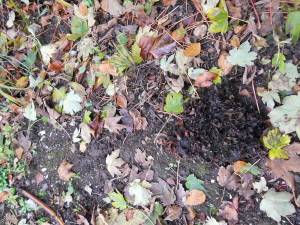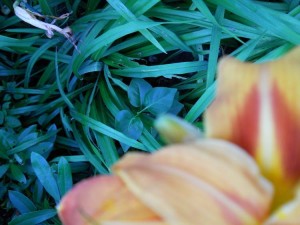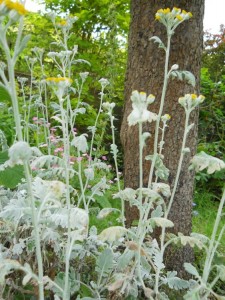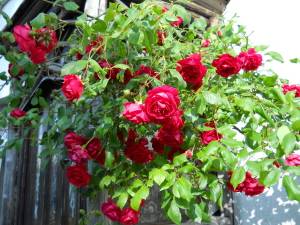Running my palm across the grainy, hard stone that formed the base of a sundial, I watched as a sudden burst of late afternoon sunshine brought the dial to life. The band of shadow fell, correctly, just before the IV on the dial. Pressing my other hand on the smooth metal arm that cast the shadow I rested, enjoying the warmth of the sun on my face. It’s been a glorious Autumn. I wriggled my hand so that a huge arthritic image of my knuckles spread across the semi circle of numbers, and thought about time in the garden. There’s never enough of it, to get everything done. It passes so quickly (unless you’re doing something truly awful, such as clearing stinging nettles in the rain). Around the golden sandstone base was some ivy and I started picking at this, pulling pieces off. Now this was wrong, because the ivy was fine there, on the sundial, appropriate somehow if you see what I mean. But ivy makes me nervous, it creeps up on you: turn your back and it’s taken over the garden, in no time at all. It wouldn’t surprise me, as I get older and slower, to find myself with a tendril of ivy climbing up my leg, eventually covering me in leaves and stems, so that I become a sort of living garden ornament. If you see a clump of ivy in your garden waving frantically, come and cut me out.
In an hours time, when good neighbours were inside and had shut their windows, I would light a bonfire, burning the waste from another Summer, marking the passing of another year. Having a bonfire is surely one of the most delightful tasks known to man (perhaps to women as well, but they never seem to have quite the same relish of the smoke and the symbolism).
Time is different in the garden; magnificently large and sure, more real then elsewhere in our rushed lives in artificially heated, artificially lighted homes and offices. The rhythm of the seasons, with flowers growing, budding and then bursting into bloom; the rhythm of each day, with the sun travelling across the sky, the temperature changing, threatening clouds gathering and dispersing, seem eternal and comforting. The line of shadow marking the hour on the sundial shuddered for a moment, almost disappeared and then sprang up firm and true in a burst of sunlight. Somehow a sundial brings such thoughts into focus. As readers will know I’m not keen on a lot of clutter in gardens, give me the plants and leave the concrete, gaily painted decking, heaps of pebbles and abstract sculptures for the television pundits. But, if you want an ornament I’d recommend a sundial, in its stillness and movement it speaks to us. However do make sure it is correctly aligned, nothing looks sillier than a sundial in Bromley that gives the time in Timbuktu or Honolulu.
Dusk had well and truly fallen as I put the last of the sweet pea stems and desiccated bean stalks on the bonfire poking it into shape with the fork, so that it would burn down slowly. I took a final satisfying breath of rich, smoky air;- was it really only eight months ago that I had watched the seeds of these plants push there first curled leaves out of the soil, feeling the awed excitement that never fails as we see life beginning? I kicked some burning leaves back into the pile sadly, watching the sparks dance round the toe of my Wellington. Yet already the vast dial of the year is turning towards a fresh start; tomorrow morning a dear client wants several hundred bulbs planted properly, ready for next Spring and there’s some exotic perennials ready to put in the ground in another garden, so I’d better read-up on them tonight, so that I know what I’m doing. These fancy plants can be as fussy as a dowager Duchess with haemorrhoids.
There was another task awaiting me after dinner, because I’ve received another email from my earnest Austrian gardening correspondent ( he of the ‘typical English garden’) and it was troubling me.
He writes;-
“A floral clock is a strange idea, because it represents a clashing interaction between a pleasure garden designed to imitate and augment nature, and a decorative feature which is frankly mechanical. Such clocks are (as far as I know) now absent from the important London parks. A famous one is still maintained in Edinburgh in the Princes Street Gardens, but it is more than 100 years old, and it is difficult to imagine any serious garden designer coming up with the idea of a floral clock today, had it not already been invented.”
I’m sure some of my readers remember when the good old floral clock, with it’s dial six feet, or more, across decorated with closely-packed bedding plants, was almost a necessary feature of any self-respecting public park. The whole face of the clock, and even the numbers on the dial, were made up of patches of brilliant clashing colours; orange Marigolds, scarlet Salvias and Geraniums, yellow Calceolarias. Often the towns crest, and even a Latin motto were picked out beneath the dial in pink or white against a background of silver leaf. Now I’m not going to have any Austrian student of Gertrude Jekyll criticising this good old British tradition, because his email carried me back to my earliest gardening memory. When I first saw a floral clock in Beckenham Place Park, at the age of four, I was entranced. The sheer cleverness, the buccaneering wit, of a clock made of flowers, delighted me more than anything, except a grubby gray monkey made of wool which I carried everywhere.
The clock was in full bloom and surrounded by old fashioned carpet bedding, with the regimented strips of bright colour appearing like great fields of flowers from my view point, down near the grass. Oscar Wilde and William Wordsworth have written of their overwhelming experiences of art and nature, but their emotions on reading French poetry or watching the moonlight shimmer on lake Windermere, were as nothing compared to mine on viewing the floral clock. A thing of beauty and a joy for ever, I watched its hand jerk forward one enormous minute in rapture. There were flowers at home, it is true, but just weedy flowers here and there, not this wholesale commitment to primary colours, and not with a real, working clock. Human ingenuity could not reach higher, so far as I was concerned.
I insisted on returning to see this marvel again, preferring it even to feeding the ducks. Indeed, so many times did I want to see it that I think my mother grew rather tiered of the floral clock; she perhaps had something in common with my Austrian correspondent in not appreciating the sublime artistry of the thing, preferring the rose garden, or the silly little plants on the rockery.
But our second visit was even better than the first. For a minute I was disappointed, because my view of the clock’s face was partially obscured; a board propped up at either end on wooden blocks stretched across it and, in the middle of this the seat of a pair of trousers blocked my view. However I gave a shout of excitement when it dawned on me that I was watching the flower-clock man at work, if not from his most photogenic side. At that time I did not differentiate one aspect of work from another: so far as I was concerned he had invented it, designed it, constructed it and planted it. Fascinated I worked my way round the circle until I could see what he was doing and, watching his busy fingers picking off the faded flowers and pulling out every invasive weed, understanding dawned for me. Gardening was work. If, like me, you plant a few dozen annuals to brighten the garden and then you weed and feed, water and dead-head, keeping them going all Summer, you will understand how much work there must be in maintaining many thousands of plants in full bloom all the Summer long. The lovers of tangled romantic greenery or of neatly shaped shrubs may sneer at the carpet bedder’s geometric patches of eye-wateringly bright colour, but must admit his devotion. I mean, all those hours kneeling on a wooden board, bent double like a Muslim at prayer, must be good for the soul or something. To me he was a hero: my sight was sharp then, and I can still see the thick fingers, stained by earth, with their large dirty nails, moving rapidly through the yellow flowers. Some boys dream of driving a train, or of being Prime Minister; for many weeks I dreamt of being a flower-clock man. Perhaps I still do.
Now, nearly fifty years later, travelling around West Wickham from one gardening job to another, my eyes are drawn to the front gardens. If there’s a battered old Rover on the road in front of you going slowly, don’t honk too loud, it makes me jump. These little patches of green in front of each house are fascinating, like miniature paintings where the tiniest details count. Don’t think I’m nosy, but they offer a sort of public introduction to the house and give a tantalising suggestion of what the people who live there are like. Some people want to cram it all in, with the lawn, trees, shrubs and flowers fighting for space and light, like a country house garden shrunk in the wash. Shy souls hide behind a good thick hedge, sacrificing their view and light for privacy. To others the only answer seems to be to put it to grass; simple, four-square and practical. The soft hearted, who cannot bring themselves to wield the pruning saw, allow one or two plants to take over;- Magnolia’s are beautiful in flower, but just go on growing: eventually even the grass gives up beneath them. Years ago a neat rose bed was a popular way of introducing yourself to the postman and the world;- bright and reliable Now it’s more popular to pave the garden over, turning it into a car park; what this says about you stop and think.
Admiring one little bed of annuals, like an elegant chocolate box, nestling under the front wall of a garden in Coney Hall, brought the flower-clock man floating into mind. For a moment I was back on the grass watching him at work, admiring the brilliant colours around the clock in the dazzling sunshine of that summer long ago. The old ambition stirred in me, if you get my drift, and, in a flash of inspiration it came to me, that here was the place to realise it. A suburban front garden is the perfect setting for my long delayed floral clock. Think about it if you would: the size is right, since it needs only a few square yards, and the site is right, being full in the public eye, yet not under the public foot.
Gardening fashions and fads come and go; crazy paving gave way to block work; Privet hedges to Red Robin; rose beds to sharp-leaved succulents in pots; heather beds, rockeries, ‘dwarf’ conifers, wild flowers, railway sleepers even old car tyres, have had their day, so why not the floral clock? Surely its hour has come. My fingers are itching to get to work.
Do you want to be in the forefront of garden design? Ahead even of Monty Don or Alan Titchmarsh? (Neither of whom, you will note, have yet mentioned the floral clock – but they will.) How many times have customers demanded something to give their garden the ’Wow’ factor, and, if my flower-clock doesn’t quite do that it will surely have the ‘WHAT!’ factor in spades.
Won’t you be a visionary, a true patron of the arts? Think how the quirky and unusual attracts the eye of the passer-by and brightens their day. There used to be a flag pole in one front garden in Coney Hall and the owner had a wonderful selection of flags; Union Jack, Welsh dragon, Chelsea football club, even a Russian hammer and sycle, and I never forgot to look to see what he was flying. Another garden had an old boat in it planted all over with flowers – these things caught the eye. Your garden can too. Say the word and I’ll find out about the mechanism, and get a price for a few thousand Marigolds and so on. Sundials be damned we don‘t live in the middle ages. Let’s get started, because I’ve been waiting fifty years for this.












